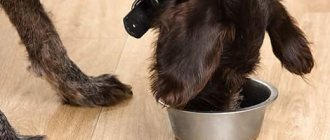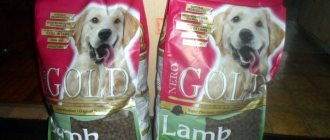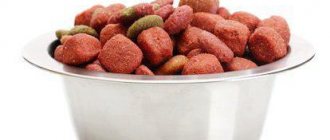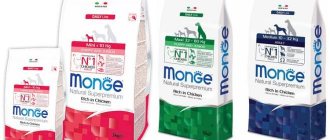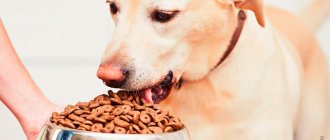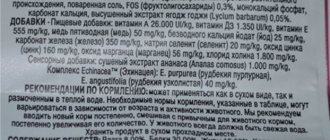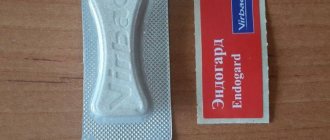When a beautiful white puppy appears in the house, the new owners do everything possible so that the baby grows up and becomes a beautiful, healthy and strong dog. Correctly selected care will help with this.
First of all, you should think about nutrition. The right food should be suitable for the dog’s breed, provide it with all the necessary vitamins and minerals, and maintain the health and beauty of the pet.
Food for white spitz puppies
There are three main ways to feed dogs - dry food feeding, natural food feeding and combination feeding.
But no matter what method you choose, it is worth considering that in any case, the bitter orange along with food should receive all the substances described above in the required ratio. Feeding a Spitz with dry food has a wide range of advantages: it is much easier to feed “dry” than to prepare different food every day, taking into account the balance of vitamins, minerals and other things, therefore, you save time on preparing food; dry food is already balanced in mineral and vitamin composition; no additional additives are required in the diet; ease of storage; Convenience of feeding during travel and transportation.
When you pick up your Spitz puppy from the breeder, ask him for the dry food he fed the puppies. It will be enough for the first few days, after which you can choose the appropriate food yourself.
How to choose high-quality and good food for your Spitz? The food rating is presented on the website: www.dogfoodrating.ru Currently, there are four categories of dry food on the market: economy class, premium class, super premium class and holistic food. A distinctive feature of good food is that meat comes first in its composition, its type is indicated (it can be whole, for example, chicken, or chopped), its percentage is indicated - at least 25% of the total composition of the food, there are two or more sources animal protein (eggs, fish products, meat products, such as liver). Also, an indicator of good food is a high degree of digestibility, and the better the digestibility process goes, the lower the feeding norms indicated on the packaging, that is, the less food the dog needs to eat per day (see the “Feeding norms” block on the bag of food).
Premium food differs from economy class food in the absence of by-products. They contain animal or poultry meat (chicken, beef, etc.) or fish, additives in the form of cereals and vegetables (no more than 50%). But the meat content is small, there is a lot of water and poorly digestible components; Feed digestibility is average.
Happy Dog (Happy Dog); Pro Pac (Pro Pak); BioMill (BioMill); Nutro nuggets (Nutro nuggets); Doctor Alders (Doctor Alders); Flatazor (Flatazor), etc.
Super premium food is very close to natural nutrition and has an excellent balance of proteins, fats, and carbohydrates. It contains only pure meat (turkey, chicken, lamb or fish), barley, which has a beneficial effect on heart health, oats - to improve digestion, hypoallergenic rice, dried tomatoes - a source of vitamins. You will never find ballast substances or dyes in them. They have tremendous digestibility, so they justify their price.
Super premium food:
Eukanuba (Eukanuba); Hills (Hills); Iams (Yams); Pro Pac (Pro Pak); Nutro Choice (Nutro Choice); 1st Choice (First Choice); ProPlan (ProPlan); Royal Canin (Royal Canin), Bosh (Bosch); Happy Dog (Happy Dog); Petreet (Retreat), etc. For Spitz, for example, Canadian 1st Choice for small breed dogs is suitable, which contains L-carnitine and prebiotics, has a good chicken content - 30%, French MD-25 food. According to Royal Canin, we can say that after the company opened production in Russia, the quality deteriorated significantly, as evidenced by numerous reviews from pet owners. But the company’s smart policy allows their products to remain in the super-premium niche.
New generation food Holistic (holistic) contains proteins of animal origin that were grown without the use of hormones and antibiotics, and plant ingredients - without chemicals and pesticides, do not contain genetically modified organisms and plant proteins. Called to heal and bring harmony.
Orijen (Orien or Orijen); Acana (Akana); Chicken Soup; Merrikk California Naturales
Source
Why is it harmful?
It should be remembered that the product can only be beneficial in small quantities. If consumed in large quantities, bread can cause significant harm to a dog's health. Carbohydrates in quantities greater than the body needs can cause obesity and diabetes. Decorative “sofa” pets that lead a sedentary lifestyle are especially susceptible to severe weight gain. Obesity can result in joint problems and disruption of the heart muscle.
Bread contains yeast that can stimulate fermentation even in the intestines. The result is disruption, changes in intestinal microflora, dysbacteriosis, and flatulence. Fresh food in the pet's stomach turns into a dense paste-like substance, which can lead to intestinal obstruction or volvulus. In such cases, surgical intervention cannot be avoided. Large amounts of white bread can cause constipation.
Feeding bread has a negative effect on dogs with heart disease, as well as on weak, elderly pets. High-carbohydrate foods require the body to expend energy for digestion and assimilation, creating additional stress on some organs and vital systems. In the above cases, it is better to avoid unnecessary loads.
What is the best food for a Spitz: rating of TOP-9 popular diets, reviews and cost
Our rating today is about how to choose high-quality, balanced and healthy food for your Spitz. It is impossible to answer unequivocally which diet will be best for a particular dog - food is selected individually, and you need to look at the dog’s reaction: behavior, condition of coat and skin, digestion and stool. However, there is a rule: the smaller the dog, the more delicate and capricious its digestion, so Spitz dogs (regardless of the type) need to be fed “super-premium” or “holistic” diets.
It is worth understanding that only dry food can be considered complete food, which the dog must eat on an ongoing basis. If desired, you can include wet food and pates in your pet’s menu - they are chosen from the same brand as the main food. Let us immediately note that the animal’s reaction to any food will be individual, so when choosing a diet you need to focus on the condition and behavior of a particular dog.
Features of feeding a French bulldog
Despite their excellent appetite, French bulldogs are quite picky eaters. You need to try to find high-quality food that your pet will like and suit him in all respects. Pampering a dog is unacceptable.
When organizing feeding bulldogs, several rules are followed:
- French Bulldogs are fed at the same time every day.
- They give a portion size that corresponds to the norm; the dog should be satiated, but not overeat.
- The diet includes proteins (50-60%), fats (30-20%) and carbohydrates (30%).
- Food needs to be fortified and enriched with microelements.
- Do not feed prohibited foods.
Differences between super-premium and holistic foods
All dry food is divided into four categories: “economy” (budget, made from low-quality raw materials), “premium” (the composition is better than that of “economy”, but also contains preservatives, flavorings, dyes), “super-premium” and "holistic". The last two classes differ significantly in cost, but contain all the necessary ingredients for the full life and health of the animal. Let's talk about the features of these classes of feed in more detail.
Table. Comparative characteristics of “super-premium” and “holistic” feeds
| Type | Description |
| Super premium |
|
| Holistic |
|
Natural feeding
If the owner has chosen natural food for his Frenchie, it should be varied and include the maximum amount of high-quality and healthy products:
- Lean meat (rabbit, beef, turkey, chicken).
- By-products – lung, heart, liver.
- Fish (boiled) - pike, perch, carp, hake, herring, capelin.
- Vegetables - carrots, cabbage, zucchini, pumpkin (both raw and boiled).
- Dairy products – only occasionally (ryazhenka, milk, cottage cheese, kefir).
- Fruits – used as a treat (peaches, bananas, apples).
Many breeders believe that a straight French Bulldog develops quickly. Meat products help build muscle mass, while fish products make the coat thick and shiny. But natural nutrition also has its disadvantages - you need to spend a lot of time preparing food, and it is difficult to create a balanced diet.
Diet for Obese French Bulldogs
The French Bulldog loves to eat, so it is prone to overeating and obesity. Most often, the culprit of the problem is the owners who feed their pet without following the rules and regulations. To avoid excess weight in your Frenchie, you need to regularly monitor his diet, walking and physical activity.
At the first signs of the appearance of excess weight, you need to increase your walking activity and feed with dietary “drying”:
- Hill's Prescription Diet i/d Digestive Care.
- Royal Canin Hypoallergenic DR21.
- Purina for obese adult dogs.
The pet should be weighed periodically and not allowed to eat a lot. If the weight increases, you should seek help from a veterinarian.
What should a French Bulldog not eat?
Despite the fact that a French bulldog can be fed both “natural” and “dry”, there are a number of foods that are strictly not recommended.
The following are prohibited:
- bread and pastries, especially with yeast and margarine;
- pasta;
- citrus and exotic fruits;
- sugar and chocolate;
- fried, smoked, pickled;
- sausage;
- food with marinade, spices, vinegar;
- onion and garlic;
- mayonnaise;
- tubular bones;
- grape;
- River fish.
It is unacceptable to feed a puppy or an adult dog with leftover food from the owner’s table. As a treat for the bulldog, they buy special treats that contain only meat and starch.
Vitamin and mineral supplements for dogs
To create a complete, balanced diet, the food of French bulldogs needs to be enriched with vitamin and mineral supplements. Their source is meat and bone meal, which contains not only proteins, but also minerals:
- Sodium and chlorine (table salt) are necessary to maintain osmotic pressure in tissues and cells.
- Potassium – regulates water content in tissues.
- Calcium is a component of nerve cells.
- Copper and iron – promotes the formation of hemoglobin in the blood.
- Sulfur is a necessary element for the functioning of the body.
- Phosphorus – participates in the structure of bone tissue.
- Iodine is part of the hormone thyroxine, produced by the thyroid gland.
Choosing wisely
Let's say that you have already decided what your pet will eat. Now you need to make another difficult choice - choosing the best dry food for your dog. To do this, several points must be taken into account.
The dog flea is one of the most common types of fleas.
Individual characteristics
The most important point when choosing dry food is to find out the individual characteristics of your four-legged friend. These include:
- Dog breed
This criterion is very important. It is he who speaks about the size and weight of the dog, how long the coat will be and other breed characteristics. You can also find out what diseases may plague your pet specifically.
- Activity
Your pet can live in different conditions - in an apartment, an enclosure. He may lead an active lifestyle, or may not leave his home. This must be taken into account when choosing food. Otherwise, your friend will suffer from either exhaustion or obesity.
- Age
An important point that must be taken into account. After all, depending on their age, animals need different amounts of energy and different compositions of nutrients. You will be interested to know how long dogs live.
That is why all manufacturers, without exception, have in their product line both dry food for adult dogs of various breeds and ages, and for small puppies.
- Presence of diseases
Every dog can get sick, or maybe there are some diseases from birth. Therefore, the animal’s nutrition in such cases should be special, adjusted for the disease.
- Pregnancy and nutrition of puppies
This applies, of course, to female pets. During such a period, nutrition should be adjusted taking into account the interesting position of the dog.
- Pickiness and pickiness
This factor may also be important. Dogs, like people, have their own taste preferences, which must also be taken into account when choosing food.
Cheap or expensive?
This is another difficult question that animal owners must decide when purchasing.
The very concept of “inexpensive dry dog food” does not mean that it is bad. There are no clear recommendations here. After all, its price has many components.
After all, you can use only high-quality ingredients and carry out production strictly according to the rules, which will affect a fairly high price.
Or you can spend a lot of money on advertising, and put quality last. But the price of such a product will also be quite high due to advertising costs.
And if a manufacturer is just starting to produce his products, then he can set a small price for his goods. But this does not mean poor quality, it’s just that a new product is gaining a place in the sun.
Every dog owner has eyes to read the composition and draw the appropriate conclusions. In addition, you need to ask other dog lovers what kind of food they prefer. It doesn’t hurt to ask the breeders what your little pet’s parents prefer to eat.
If you have cats at home in addition to dogs, we advise you to learn everything about Kitekat and Hills food.
The only thing that can be said without a doubt is that when choosing the type of food for your pet, pay attention to the presence of synthetic flavors, dyes and preservatives.
Important! The dog definitely does not need synthetics. If it is included in the feed, then the manufacturer will probably conceal in this way low-quality products and violations in the production process.
Don't forget to consult a veterinarian
Of course, a good veterinarian should be your main advisor when choosing food.
After all, these specialized doctors know how the dog’s body functions. They can tell you exactly how much protein, fat and carbohydrates your pet needs.
In addition, veterinarians have a large circle of contacts with dog breeders (often they themselves are one), who can tell about the quality of a particular product.
Causes of tear stains
As far as we know, in white dogs, tearing and coloring of the coat can be associated with a variety of reasons, and not at all with the high content of total protein in the food. The appearance of these spots is a complex process, and to prevent them you need comprehensive dog care.
Let's name several reasons for tear stains around the eyes and dark coloring of the muzzle in the area of the mustache and beard in white dogs:
- reaction to food (allergy to one or more components of the diet);
- reaction to tap water (the composition of tap water, unfortunately, leaves much to be desired and can cause negative reactions);
- drinking from a wide bowl (leads to very wet wool, and constantly wet wool can turn yellow or pink);
- a plastic bowl that the dog touches with wet fur in the muzzle area (cheap plastic can release harmful substances that contribute to coloring of the fur);
- lack of regular care (the pet’s eyes and face are not wiped 2-3 times a day with special napkins);
- consumption of large amounts of wet food (the area around the mouth is constantly dirty);
- Lack of regular use of lotions to remove tear stains (regardless of the reasons, these products are necessary to minimize darkening around the eyes).
Another reason for persistent watery eyes and tear stains may be the contamination of the tear duct with bacterial flora. There is a favorable environment for the proliferation of microorganisms. You should show your dog to a doctor, especially if redness is noticeable or the dog experiences discomfort and rubs its eyes.
